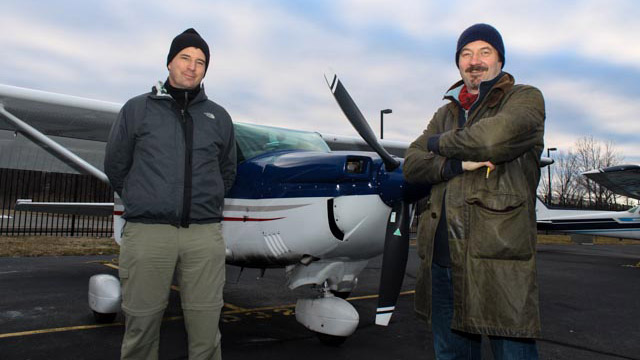Flying club's Cessna 182 makes biofuel flight
Retrofitted Jet-A 182 harbinger of things to come
Kill Devil Hills, N.C., was the site of another aviation milestone March 2 when a Cessna 182 retrofitted with a SMA diesel engine landed at First Flight Airport (KFFA). Pilots say it is the first general aviation flight in the United States powered by cooking-oil-based SkyNRG biofuel in a piston engine.
While the flight could be a sign of what aviation fuel may look like in the future, what is more significant is that a diesel engine for light aircraft using Jet-A is here today.
The diesel piston aircraft engine is made by the French manufacturer Societe de Motorisations Aeronautiques (SMA). Thierry Saint Loup, vice president for SMA Engines, prefers to call it a Jet-A piston engine. “I try to avoid the word diesel just because I don’t want the public think that we put diesel fuel in it,” he said. “It is a diesel cycle engine, or compression ignition engine, as opposed to a spark ignition engine. But it’s not certified to burn diesel fuel.”
Cessna generated quite a buzz at EAA AirVenture in July 2012 when it announced a Jet-A-powered 182 would be available in the second quarter this year, a goal that appears to be on schedule. But to the members of the Paramus Flying Club it was old news—they’ve been flying one since 2009. In fact, the engine that will be in Cessna’s JT-A is an enhanced version of what is under the distinctive cowling of the club’s Cessna 182.
Based at Essex County Airport (KCDW) in New Jersey, the club converted its 1980 Cessna 182 after an incident involving a snow bank required replacing everything from the firewall forward. It wasn’t cheap with a price tag of about $80,000, but Paramus Flying Club President Chris Howitt says it was well worth it.
“Based on SMA’s figures, and the data we were getting, we were fully expecting to be able to rent our 182 cheaper than our 172,” Howitt said. That’s because the engine, which is certified by the FAA, European Aviation Safety Agency (EASA), and IAC-AR (Russia), burns about 8 to 9 gallons of Jet-A per hour, compared with 13 to 14 gph of 100LL for a traditional Cessna 182.
The biofuel flight to Kitty Hawk from North Central State Airport (KSFZ) in Rhode Island covered 500 miles in three hours and 45 minutes with a fuel burn of just 7.8 gph. The biofuel—a 50-50 blend of used cooking oil, which is refined, and Jet-A—is produced by the Dutch company SkyNRG and has been used successfully in commercial aircraft. The return flight, in which regular Jet-A was added to the remaining biofuel, resulted in a slightly higher fuel burn of 9 gph because of the higher takeoff weight associated with more fuel on board, Howitt said.
“The SMA aviation diesel engine is 30 to 40 percent more efficient than your typical avgas engine that’s in that plane,” said Ross McCurdy, a Ponaganset High School science teacher leading the club’s biofuel efforts. His goal is to fly the airplane from Rhode Island to California using only biofuel.
Enhanced engine for the JT-A
There are approximately 40 Cessna 182s around the world being flown with SMA’s first generation of the engine, the SR350-230-1, Saint Loup said. It is a horizontally opposed, four-cylinder, turbocharged, air/oil cooled, diesel engine that is rated for continuous power at 2200 rpm. It has full authority digital engine control, so there is a single lever replacing the throttle, mixture, and prop controls, and it is pulled by a three-bladed MT composite prop.
Many of the aircraft flying with the supplemental type certificate are being used for mission aviation work in Africa and Latin America, where avgas can be difficult to find and often quite a bit more expensive than in the United States.
SMA gathered data from these aircraft to improve the engine, resulting in the SR350-230E or “enhanced” model, which will be on the new Cessna. Saint Loup estimates the -1 version of the engine has flown more than 50,000 hours between testing and customer operations. The Paramus Flying Club has 750 hours on its engine.
“There were some limitations on the engine,” Saint Loup said. “That’s why you don’t see a whole lot of STCs in the field. The goal was to remove those limitations and increase the ceiling to 20,000 feet and improve many things around the engine, whether it’s to improve operations in cold weather or hot weather.”
That has been accomplished. The E model is certified up to 20,000 feet, where the STC for the -1 model was only certified to 12,500, Saint Loup said. Perhaps the most significant difference is the enhanced version is rated at 230 horsepower up to 10,000 feet with a dropoff in horsepower between 10,000 and 20,000 feet. The -1 was rated at 230 hp only up to 5,000 feet, and would experience a drop to 200 hp between 5,000 and 10,000 feet. The enhanced model also has an increased TBO of 2,400 hours compared with 2,000 hours.
SMA is no longer producing the -1 version and doesn’t intend to do any more STC conversions. “We did the first one to monitor the market, to be out there and get the product going. Our core competency is really the development of engines and the production of the engines,” Saint Loup said. “That’s why we’re concentrating now with all the OEMs asking us for the engine. If there is a company that wants to develop an STC for a particular airplane, we’d consider working with them so they can deliver the STC.”
While converting another aging Cessna 182 to an aviation diesel engine burning Jet-A is unlikely, at least for now, buyers of Cessna’s new JT-A can have confidence that there is a proven engine up front that has been flying for years.



